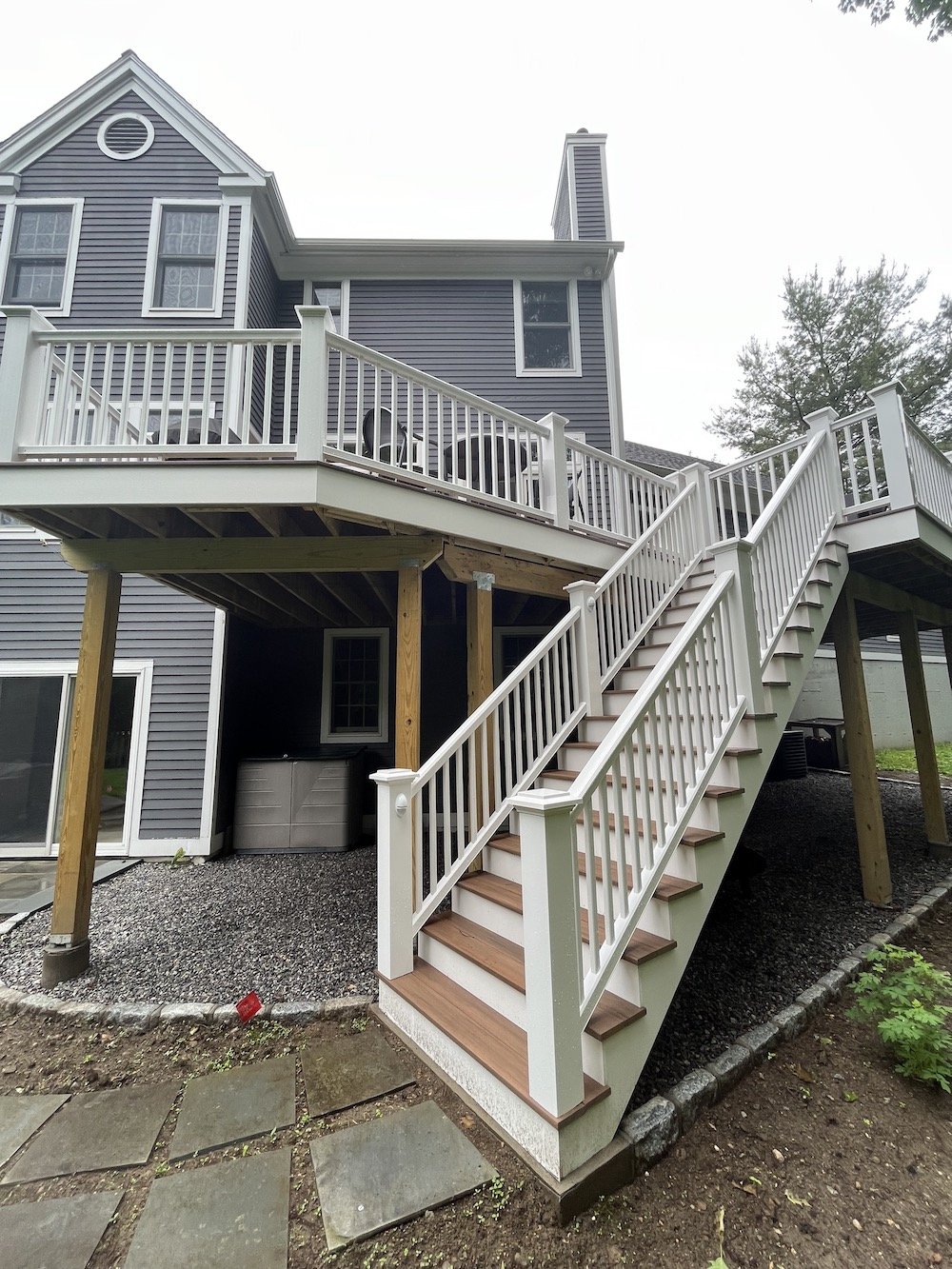How Much Does a Deck Cost?
Gone are the days from the ‘90s when one would grab some pressure treated decking and put together a deck in a few weeks. More and more, today’s clientele are opting for more elaborate designs and maintenance-free options that will last decades. Such decks enhance the overall function and beauty of the home, but come with a higher price tag previous generations.
It’s been decades since we’ve built a “simple” deck, and nearly all of our clients are using PVC and composite decking and railing material for a maintenance-free deck that will last decades. This means a larger investment at the outset and a bit of research into the cost/benefit of each special product. Also, every property is unique, and every aspect of your deck design and each requirement of your local building department will affect your project costs. In this article we’ll try to give you some reasonable cost expectations and present some of the key factors that drive cost.
PLANNING FIRST
BLUEPRINTS WILL BE REQUIRED
If you’ve read my other articles, you already know I’m going to bring this up first! For a new deck, the local municipality will require architectural blueprints for the application for a building permit (See our article “Do I need a building permit?”) The architect will have to work with your property survey to be sure the deck falls inside the property setbacks (see below for information regarding setbacks).
Deck and Patio Blueprints
What are setbacks? Each town has a specific number of feet from the property line in which you may not build. The number of feed depends on your property’s zoning and is different in front, rear and side yards. Part of a feasibility study of a deck is to check your zoning, survey and setbacks to see if you can legally build a deck where you have in mind.
If the property lines are so constraining that you can’t build a viable deck within the setbacks, you may consider applying for a zoning variance. We’ll discuss this in more detail in an article on Zoning, but for now it’s important to understand that an application for a zoning variance is a request to relax zoning regulations for a special case. There is no guarantee that the zoning board will approve an application, so when possible, a compliant project is much safer.
Understand your setbacks and property lines before you begin.
It’s always easier to plan for a compliant project on the frontend, than to disassemble, reapply, and redo a project on the backend.
Aside from permits, what else are blueprints used for?
BLUEBLUEPRINTS HELP TO UNDERSTAND PRICING. Blueprints enable the builder’s pricing to be tied to a set of detailed design drawings to prevent oversights or miscommunications and they are a valuable tool for properly pre-ordering specialized decking and railing parts.
BLUEPRINTS HELP WITH LAYOUT AND ACCESS. These blueprints are used to define the layout of the new deck, figure for the access to your yard (stairs), specify safe and code compliant railings, as well as figure out convenient access from your home. Some of our deck projects involve creating a new sliding or French door to the new deck, enhancing the interior as well as the exterior living space. A good flow between interior and exterior living spaces is a big factor in your enjoyment of the new deck.
COST CONSIDERATIONS
Two of the most obvious cost factors are deck size and deck shape.
DECK SIZE
25 years ago we were commonly building decks about 16 ft. x 16 ft. But today’s clients often want a lounging area and a dining area – so a larger space is needed. For purposes of this discussion, we’ll talk about a 24 ft. long deck that projects 20 ft. from the house.
DECK SHAPE
The most cost efficient shape for a deck is a rectangle. Since conventional lumber maxes out at about 20 ft, and the joists nearly always project out from the house, many decks project between 16 ft. to 20 ft. from the house. The long direction of the deck is usually parallel to the home. When the design is embellished to introduce angles, multiple levels, multi level staircases with landings, or complex shapes, the cost per square foot increases.
Let’s take a closer look at the specific key cost drivers for a deck project:
Structural Requirements: A basic square deck has pretty straightforward structural requirements, but if your deck has multiple levels, curves, special shapes, staircases and landings, thoughtful structural engineering will have to be implemented. Also, most municipalities have an ever increasing list of requirements for structural fasteners, lateral load stabilizers, and specialized hangers to be sure the deck is completely rigid, strong and storm resistant. Sometimes when we see the structural specs, we figure if the house ever falls down, the deck will still stay up!
Deck with Multiple Levels
Stair Configuration / Design: If your deck is a few feet above grade, the stairs can be relatively low cost part of the deck project. However even a short set of stairs will need a code compliant balustrade on either side. If the deck is elevated, say 8-10 feet in the air, the stairs become a bit more major, with 4 full sections of balustrade and sometimes mid span support. Complex stairs and landings are the most costly, since they require additional masonry footings and structure.
A full story flight of stairs requires 4 full sections of balustrade
Decking Selection and Installation Method: The range of prices on decking material is broad. A high quality Advanced PVC decking from Azek/Timbertech ranges from about $5 to $8 per foot. Some composite decking boards can come in at a lower price point than this but there is usually a trade-off. For example at this writing, Timbertech’s Terrain composite in Silver maple is beautiful, but the boards have a scalloped shape. This is really only noticeable on the ends of the stairs. Also, beware of cheap composite deck boards that are only capped on 3 sides, since they are more susceptible to moisture. Hidden fasteners with special clips or screws and plugs cost about $1.60 per square foot, plus about $1.30 in labor. So on a 480 square foot deck, this option alone adds about $1,400.
Question: Did you specify the decking and fastener in the design phase for accurate pricing?
Stairs with Scalloped Profile
Railing Options: Our most popular railing system is Timbertech premier white composite railing system [Insert Photo: “5. Timbertech Railing”] It is 100% maintenance free, doesn’t look shiny and plastic, looks beautiful and traditional and is well engineered for installation. A step up from here in cost is a powder coated Timbertech Impression rail. Also, 100% maintenance free, it has a more visually transparent and modern look. And the most expensive railing system is a stainless steel cable rail. The most costly, but also the most visually transparent, short of glass!
**Be sure to specify the railing system on the blueprints
Timbertech Railing
Lighting and Outlets: The design phase will consider code required lighting, safety and security lighting. At a minimum, the code requires an exterior light at each entry from the home to the deck, and at least one weatherproof Ground Fault protected outlet. A larger deck will benefit from 2-3 wall sconces, or even a motion sensor flood light. Low voltage post, railing or riser lighting is a beautiful enhancement of a deck, providing a softer light for evening enjoyment and entertainment.
Deck with Accent Lights
Stormwater Management / Erosion Control: After recent severe storms and flooding, many municipalities have a sharpened focus on stormwater management. Some towns consider decks to be “Impervious surfaces” and almost all municipalities now have regulations regarding how much of your property can be “Impervious” vs. green spaces of grass, gardens, etc. In some towns, the building department will require the installation of a drywell or other measures. This gets revealed in the permit application and plan review phase, but it’s good to be ready for this possibly unexpected cost/deck size limitation.
SAMPLE BUDGET
To give you an idea of prospective costs, here is a sample budget for a gorgeous rectangular deck approximately 20 ft. x 24 ft = 480 square feet with some stairs to the back yard.
Deck Project Components
| Type of Work | Estimate |
|---|---|
| Demolition of an existing deck, removal of existing stairs or patio? | $2,000 |
| Disposal of debris from demolition of an old deck and construction of the new | $1,300 |
| Masonry and Footings: Approximately 4 concrete footings and a concrete landing pad for the stairs | $2,500 |
| Deck Framing Labor | $10,000 |
| Deck Framing Materials: Pressure treated framing lumber and posts, structural connectors | $6,000 |
| Decking, Trim & Stairs Labor | $9,000 |
| Decking & Trim Materials: Here we use a Timbertech slate grey PVC decking at $5 / foot for our sample | $15,000 |
| Railing Construction Labor: A budget for our most popular railing style – the Timbertech premier white composite railing system | $8,000 |
| Railing System Materials: Posts, rails, balusters, post caps, specialized hardware kits | $6,000 |
| Electrical: A budget for (2) new sconces at the exterior, a new GFI outlet, and (6) Low voltage accent lights | $3,000 |
| Sample Composite Deck Construction Budget as of 6/2023 | $62,800 |
A Note on Pricing
Naturally, to get numbers properly personalized to your deck project, you’ll have to go through a thoughtful design phase with detailed blueprints which the builder can use to provide accurate pricing. Some builders always feels like they are going out on a limb providing budgets since if their numbers feel high to the client, they might get scared away and start a dialogue with a different builder who offers optimistic lowball budget numbers, which later rise to match the veteran builder’s numbers on final pricing, or worse, after the project starts. On the other hand, if the budget presented is low, a client may be shocked when their custom project comes in higher.
Go with a Trusted Builder
From initial budget conversations all the way through to final pricing, cost information is only meaningful if it is from a trusted builder. Avoid the “too good to be true” estimates or vague 1 page estimate documents with cop outs like “work per blueprints” with lots of “surprises” and extras once the project starts. Check out our article on “How to select the Best Builder” to do a great job interviewing builders and avoid these pitfalls.
How might this budget help you?
A little too high: If this number is a little higher than your target spend, you could consider trimming by reducing the electrical work, a lower cost decking product, reducing size or going with an exposed fastener system to save.
Out of the ballpark: If the number is way out of the ballpark, it doesn’t seem to make sense to invest in the detailed design phase.
The budget works: If the number works, you can design with confidence, knowing you will build your new deck!
That’s the beauty of design-build – knowing the numbers along the way so you are sure the final project design can be built.







